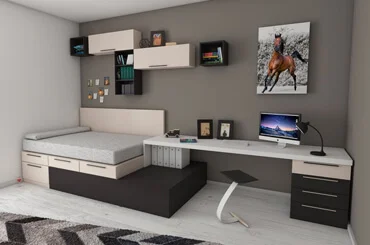
Embracing the Zeitgeist: Exploring Contemporary Interior Design Trends
22nd April | Ivy Habitat
In the ever-evolving world of interior design, contemporary styles stand at the forefront, reflecting the current ethos and aesthetic preferences of the times. Characterized by sleek lines, minimalism, and a focus on functionality, contemporary interior design encapsulates the spirit of modern living. Today, let's delve into the
realm of contemporary interior design, exploring its defining features, popular trends, and the ways in which it shapes our living spaces.
Understanding Contemporary Interior Design
At its core, contemporary interior design embodies a sense of "here and now." It draws inspiration from various design movements, such as modernism and minimalism, while also incorporating elements of other styles to create a cohesive and visually appealing space. Unlike traditional design styles that may be steeped in historical or cultural references, contemporary design embraces simplicity, clean lines, and open spaces.
Key Elements of Contemporary Design
- Clean Lines and Minimalism: Contemporary interiors often feature clean, straight lines that create a sense of simplicity and sophistication. Minimalist design principles dictate that every element should have a purpose, and unnecessary clutter is eliminated to achieve a streamlined look.
- Neutral Color Palettes: Neutral colors such as white, beige, gray, and black dominate contemporary interiors, serving as a backdrop that allows other design elements to shine. These subdued hues create a sense of serenity and timelessness, while pops of color or bold accents can be introduced through accessories or artwork.
- Open Floor Plans: Contemporary design embraces the concept of open space, blurring the boundaries between different areas of the home. Open floor plans allow for seamless flow and connectivity, making rooms feel larger and more inviting.
- Integration of Natural Elements: While contemporary design tends to favor sleek surfaces and materials like glass, metal, and concrete, there's also a growing emphasis on incorporating natural elements such as wood, stone, and plants. This juxtaposition of materials adds warmth and texture to contemporary interiors, creating a harmonious balance between the man-made and the organic.
- Emphasis on Functionality: Functionality is paramount in contemporary design, with furniture and fixtures chosen for their practicality as well as their aesthetic appeal. Multi-functional pieces that serve more than one purpose are favored, especially in smaller living spaces where versatility is key.
Contemporary Design Trends
- Sustainable Design: As environmental consciousness grows, sustainable design practices are becoming increasingly prevalent in contemporary interiors. From eco-friendly materials to energy-efficient appliances, there's a growing emphasis on creating spaces that are both stylish and environmentally responsible.
- Technology Integration: With the rise of smart home technology, contemporary interiors are increasingly incorporating high-tech features that enhance comfort, convenience, and connectivity. From automated lighting systems to integrated sound systems, technology seamlessly integrates into the design, enhancing the overall living experience.
- Biophilic Design: Biophilic design principles, which emphasize the connection humans and nature, are gaining traction in contemporary interiors. Incorporating elements such as indoor plants, natural light, and organic materials not only enhances the aesthetic appeal of a space but also promotes health and well-being.
- Artisanal Craftsmanship: In contrast to mass-produced furnishings, contemporary interiors are embracing artisanal craftsmanship and handmade pieces that showcase unique textures, patterns, and cultural influences. These one-of-a- kind items add personality and authenticity to the space, creating a sense of warmth and individuality.
Conclusion
Contemporary interior design is a reflection of our evolving lifestyles, preferences, and values. It celebrates simplicity, functionality, and innovation while embracing the beauty of natural materials and the principles of sustainability. As we continue to adapt to changing times, contemporary design will undoubtedly evolve, yet its
essence of timeless elegance and modern sensibility will endure, shaping the way we live and interact with our surroundings.
